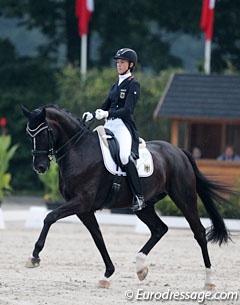
With overpowering force the German junior riders’ team claimed team gold in the nations’ competition at the 2017 European Junior and Young Riders Championships held in Roosendaal, The Netherlands, on 9 -13 August 2017. Lisa Welschof led the German campaign to glory by besting the field with the high score. The Netherlands took silver and Denmark bronze.
There was little excitement to the team competition with a very strong Germany and the thrill was to sought in the race for bronze between Denmark and Sweden. And even with those teams, no cheering and screaming were to be heard as soon as the key riders had produced their scores on the board.
With 80 junior riders entered, the division is the largest it has ever been at a European Championship. The team championship test had to be split up into two groups, the first going on Wednesday with German Rebecca Horstmann topping the board, the second group went on Thursday morning 10 August and was dominated by Lia Welschof.
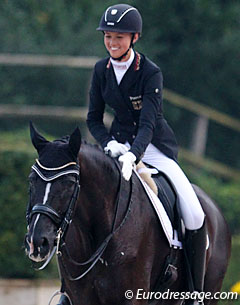 The team test was judged by an interesting panel which for once excluded judges from Germany, The Netherlands and even Great Britain. Francisco Guerra (ESP), Maja Stukelj (SLO), Maria Schwennesen (AUS), Isabelle Judet (FRA), and Magnus Ringmark (SWE) sorted out the medalists.
The team test was judged by an interesting panel which for once excluded judges from Germany, The Netherlands and even Great Britain. Francisco Guerra (ESP), Maja Stukelj (SLO), Maria Schwennesen (AUS), Isabelle Judet (FRA), and Magnus Ringmark (SWE) sorted out the medalists.
As third rider to go on Thursday, German Lia Welschof and her Hanoverian gelding Linus K (by Locksley II x Prince Thath xx) set the tone with a convincing ride. The black has a serious paddle going, but that took not away from the beauty of the ride. The horse was nicely up in the frame, showed a good balance and much solidity in the traversal movements. The rein back was top class and in the extensions he covered good ground although in the second diagonal there was a loss of rhythm. Also the extended walk was clear in rhythm and pleasing in overstep. In the right turn on the haunches the black lost some elasticity and the rhythm was compromised. The collected walk came dangerously close to pacing. The horse showed four strong flying changes and an uphill extended canter. Welschof rode with much precision and concentration and was rewarded by the judges with 74.838%. Their marks ranged from 72.703% to 77.297%
Team mate Rebecca Horstmann and Friend of Mine moved into the second place in the final team test standing (73.03%) and aided in the German effort for gold. Team Germany captured first place with a 221.379 point total.
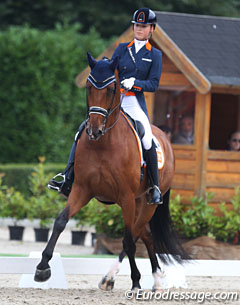 Home team The Netherlands finished in silver medal position (214.459 points), spearheaded by Daphne van Peperstraten on the 10-year old Dutch warmblood Cupido (by Johnson x Duko). The bright bay gelding has much balance in the traversal movements and lengthened well on the diagonals. His hindlegs are rather pushing instead of a carrying and the rider has her lower legs far off the horse, instead of keeping them at a quiet, close body contact. In the rein back did they not reverse the full four steps . The extended walk was very nice with a clear rhythm and plenty of overstep, the collected walk was well ridden. Only in the right walk pirouette Cupido took a larger step in the exit. The horse is very confirmed in the canter work and executes the flying changes effortlessly. Unfortunately at the end of the extended canter he changed behind and did not come properly back to the collection. They finished third with 72.865%.
Home team The Netherlands finished in silver medal position (214.459 points), spearheaded by Daphne van Peperstraten on the 10-year old Dutch warmblood Cupido (by Johnson x Duko). The bright bay gelding has much balance in the traversal movements and lengthened well on the diagonals. His hindlegs are rather pushing instead of a carrying and the rider has her lower legs far off the horse, instead of keeping them at a quiet, close body contact. In the rein back did they not reverse the full four steps . The extended walk was very nice with a clear rhythm and plenty of overstep, the collected walk was well ridden. Only in the right walk pirouette Cupido took a larger step in the exit. The horse is very confirmed in the canter work and executes the flying changes effortlessly. Unfortunately at the end of the extended canter he changed behind and did not come properly back to the collection. They finished third with 72.865%.
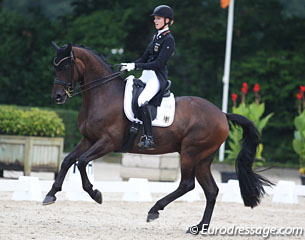 Linda Erbe and the 7-year old German Sport Horse bred Fierro (by Furst Wettin x Eskadron) were the last pair to go for Germany and expected to be the strongest combination, but the duo ended up producing the third best score for the country. Fierro was not as sharp on the aids as hoped for and needed much driving aid and support from his rider. The trot had good energy and there was nice overtrack in the medium trot. The extended walk had two hooves overstep, but was not the biggest in stride length. The right walk pirouette was tiny. Small niggles here in there kept the score from climbing higher. The third change was not on the aids and in the extended canter, Fierro could have lengthened more in the frame. Also the end halt was not immobile. They finished fourth on a 72.838%.
Linda Erbe and the 7-year old German Sport Horse bred Fierro (by Furst Wettin x Eskadron) were the last pair to go for Germany and expected to be the strongest combination, but the duo ended up producing the third best score for the country. Fierro was not as sharp on the aids as hoped for and needed much driving aid and support from his rider. The trot had good energy and there was nice overtrack in the medium trot. The extended walk had two hooves overstep, but was not the biggest in stride length. The right walk pirouette was tiny. Small niggles here in there kept the score from climbing higher. The third change was not on the aids and in the extended canter, Fierro could have lengthened more in the frame. Also the end halt was not immobile. They finished fourth on a 72.838%.
Grecian Theodora Livanos and her Dutch warmblood Winston secured a score of 71.865% on Wednesday, which landed them fifth place in the team test.
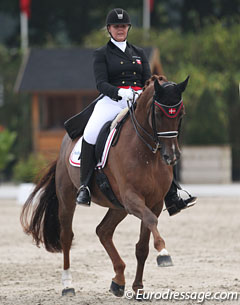 The Danish team ended up with bronze with 213.621 points in total. The team was anchored by Camilla Andersen on the 9-year old Danish warmblood mare Rafaella K (by Skovens Rafael x Hertug). The liver chestnut mare defies her young age with her incredible balance in trot, despite a lapse in the rhythm in the extension. In canter the mare moves with great uphill tendency, also in the flying changes but the third change was not through on the aids. Overall Andersen rode a very secure test which appeared effortless despite the two bumps in the road. They posted a score of 71.594% on the board.
The Danish team ended up with bronze with 213.621 points in total. The team was anchored by Camilla Andersen on the 9-year old Danish warmblood mare Rafaella K (by Skovens Rafael x Hertug). The liver chestnut mare defies her young age with her incredible balance in trot, despite a lapse in the rhythm in the extension. In canter the mare moves with great uphill tendency, also in the flying changes but the third change was not through on the aids. Overall Andersen rode a very secure test which appeared effortless despite the two bumps in the road. They posted a score of 71.594% on the board.
Danish team mate Karoline Rohmann and the 10-year old Danish warmblood mare Noosa Melody (by Don Romantic x Schwadroneur) added the second team score to the tally. They were the last pair to go for Denmark. The bay mare is nicely up in the frame and very steady in the contact, but there was a break into canter right after the halt at entry. Also in the rein back the mare could have picked her feet up more. The trot half passes were sweeping , with the right one being the most elastic, and the extensions big. In the extended walk Noosa had two hooves overtrack but got quick in the tempo. In the collected she lost some activity. The canter work was nicely uphill with four strong changes and a powerful extensions, but overall there should have been more lightness in the contact, especially in the canter work. They scored 71.378% to rank eighth.
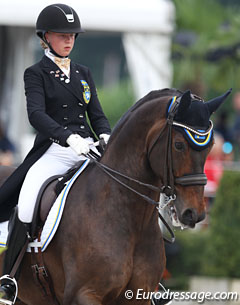 The Swedish team was on Denmark's heels and landed fourth place in the nations' ranking with 2.4% less in the final standing (211.217 points). Sweden's strongest rider of the class was Mads Hendeliowitz' student Evelina Soderstrom on the Grand Prix schoolmaster Weihenstephaner, a 19-year old Swedish warmblood by Warsteiner x Dwight. The compact bay gelding had good energy in trot and flowed from one movement into the next. Although Weihenstephaner is not the scopiest mover, he is very correct. The extended walk covered good ground but the rhythm was mediocre though. The canter work was all very solid and Soderstrom ended with 71.487% on the board and a seventh place.
The Swedish team was on Denmark's heels and landed fourth place in the nations' ranking with 2.4% less in the final standing (211.217 points). Sweden's strongest rider of the class was Mads Hendeliowitz' student Evelina Soderstrom on the Grand Prix schoolmaster Weihenstephaner, a 19-year old Swedish warmblood by Warsteiner x Dwight. The compact bay gelding had good energy in trot and flowed from one movement into the next. Although Weihenstephaner is not the scopiest mover, he is very correct. The extended walk covered good ground but the rhythm was mediocre though. The canter work was all very solid and Soderstrom ended with 71.487% on the board and a seventh place.
The top 10 was completed by Russian Anna Guseynova on the 12-year old Westfalian gelding Lauda (by Laudabilis x Florestan). Trained by Adelinde Cornelissen, Guseynova was the 2016 European Children's Champion and she has now made a seamless transition to junior rider. The trot work was steady and ridden with much control. The extended walk was good, but the first turn on the haunches a bit tense. All four flying changes were clean and uphill. Overall Lauda's nose was slightly behind the vertical at all times despite the quiet contact, and the general silhouette would improve even more with more opening in the throatlatch.
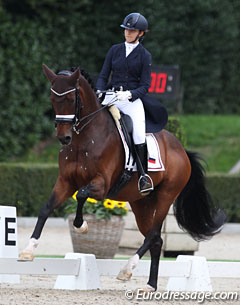 The junior riders' team test concluded round noon and with a short break for arena maintenance the day immediately went on with the Children's Preliminary test followed by the Young Riders team test part 2 until 22h00 in the dark. The team prize giving ceremony has been pushed to Friday evening.
The junior riders' team test concluded round noon and with a short break for arena maintenance the day immediately went on with the Children's Preliminary test followed by the Young Riders team test part 2 until 22h00 in the dark. The team prize giving ceremony has been pushed to Friday evening.
Text and Photos by Astrid Appels - No reproduction allowed
Related Links
Scores 2017 European Children, Junior and Young Riders Championships
Eurodressage Coverage of the 2017 European Children, Junior & Young Riders Championships